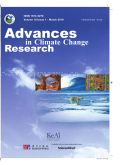- 钛学术文献服务平台 \
- 学术期刊 \
- 基础科学期刊 \
- 天文学、地球科学期刊 \
- 气候变化研究进展(英文版)期刊 \
Mid-summer surface air temperature and its internal variability over China at 1.5 ℃ and 2 ℃ global warming
Mid-summer surface air temperature and its internal variability over China at 1.5 ℃ and 2 ℃ global warming
基本信息来源于合作网站,原文需代理用户跳转至来源网站获取
摘要:
Recently, extremely hot summers occurred frequently across China, and the mean mid-summer surface air temperature (SAT) continuously broke the records of the past decades, causing huge social and economic losses. As global warming accelerates, these extremely hot summers will undoubtedly occur more frequently. However, the issue of what will happen to the mid-summer SAT over China in the near future remains unclear. Therefore, we investigate the changes of mid-summer SAT and related internal variabilities over China at 1.5 ℃ and 2 ℃ global warming above preindustrial level by using the MPI-ESM Grand Ensemble simulations. The results indicate that compared to the present-day (1986-2005), national averaged mid-summer SAT will increase by 1.1 ℃ and 2.0 ℃, in 1.5 ℃ and 2 ℃ warming scenarios respectively. This means that the mid-summer SAT is projected to increase by 0.9 ℃ due to an additional 0.5 ℃ global warming, which is higher than the annual value (0.8 ℃) and almost two times the global warming rate. Regionally, in the two warming targets, the increase in mid-summer SAT will be more enhanced over the northwestern part of China. In addition, the extremely high monthly SAT would increase nationwide due to an additional 0.5 ℃ in global warming. Among all areas, the Qinghai and Xinjiang provinces would experience the strongest increase in extremely high monthly SAT. It is important to find that, from 1.5 ℃ to 2 ℃ global warming, changes of the internal variability of the mid-summer SAT differs across China. It would decrease over some parts of western Northwest China, North China, Northeast China and the Tibetan Plateau. However, it would significantly increase over Qinghai, Sichuan, and northern parts of Inner Mongolia. As a result, at 2 ℃ global warming, the increase of extreme SAT in Qinghai is caused by the synergistic effect of stronger warming rate and larger internal variability. Differently, the increase in Xinjiang province is mainly caused by the stronger local warming. Further analysis suggests that we can effectively reduce the intensity of extremely hot months over most regions of Northwest China by limiting global warming to 1.5 ℃, rather than to 2 ℃.

推荐文章
Air-water CO2 flux in an algae bloom year for Lake Hongfeng, Southwest China: implications for the c
CO2 flux
Algae bloom
Carbon cycle
Inland waters
Lake Hongfeng
Projected changes in summer water vapor transport over East Asia under the1.5℃ and2.0℃ global warming
水汽输送
东亚
全球增暖1.5℃和2.0℃
RCP4.5和RCP8.5排放情景
Low-temperature alteration of uranium–thorium bearing minerals and its significance in neoformation
Zircon
Thorite
Xenotime
Radioactive minerals
Low-temperature alteration
Wadi El-Reddah
Spatial characters of nutrients in Wujiangdu Reservoir in karst river, SW China
Wujiangdu Reservoir
Nutrients distribution characteristics
Dam
内容分析
关键词云
关键词热度
相关文献总数
(/次)
(/年)
文献信息
| 篇名 | Mid-summer surface air temperature and its internal variability over China at 1.5 ℃ and 2 ℃ global warming | ||
| 来源期刊 | 气候变化研究进展(英文版) | 学科 | |
| 关键词 | |||
| 年,卷(期) | 2020,(3) | 所属期刊栏目 | Special topic on East Asian climate response to 1.5/2 ℃ global warming |
| 研究方向 | 页码范围 | 185-197 | |
| 页数 | 13页 | 分类号 | |
| 字数 | 语种 | 英文 | |
| DOI | |||
五维指标
引文网络
引文网络
二级参考文献 (670)
共引文献 (449)
参考文献 (54)
节点文献
引证文献 (0)
同被引文献 (0)
二级引证文献 (0)
1969(1)
- 参考文献(0)
- 二级参考文献(1)
1977(1)
- 参考文献(0)
- 二级参考文献(1)
1979(1)
- 参考文献(0)
- 二级参考文献(1)
1980(1)
- 参考文献(0)
- 二级参考文献(1)
1981(3)
- 参考文献(0)
- 二级参考文献(3)
1982(2)
- 参考文献(0)
- 二级参考文献(2)
1984(1)
- 参考文献(0)
- 二级参考文献(1)
1987(3)
- 参考文献(0)
- 二级参考文献(3)
1988(1)
- 参考文献(0)
- 二级参考文献(1)
1989(3)
- 参考文献(0)
- 二级参考文献(3)
1990(2)
- 参考文献(0)
- 二级参考文献(2)
1991(1)
- 参考文献(0)
- 二级参考文献(1)
1992(5)
- 参考文献(0)
- 二级参考文献(5)
1993(1)
- 参考文献(0)
- 二级参考文献(1)
1994(4)
- 参考文献(0)
- 二级参考文献(4)
1995(2)
- 参考文献(0)
- 二级参考文献(2)
1996(2)
- 参考文献(0)
- 二级参考文献(2)
1997(8)
- 参考文献(0)
- 二级参考文献(8)
1998(1)
- 参考文献(0)
- 二级参考文献(1)
1999(3)
- 参考文献(0)
- 二级参考文献(3)
2000(6)
- 参考文献(0)
- 二级参考文献(6)
2001(7)
- 参考文献(0)
- 二级参考文献(7)
2002(16)
- 参考文献(2)
- 二级参考文献(14)
2003(13)
- 参考文献(0)
- 二级参考文献(13)
2004(21)
- 参考文献(2)
- 二级参考文献(19)
2005(23)
- 参考文献(1)
- 二级参考文献(22)
2006(28)
- 参考文献(1)
- 二级参考文献(27)
2007(33)
- 参考文献(0)
- 二级参考文献(33)
2008(38)
- 参考文献(2)
- 二级参考文献(36)
2009(56)
- 参考文献(2)
- 二级参考文献(54)
2010(48)
- 参考文献(1)
- 二级参考文献(47)
2011(46)
- 参考文献(4)
- 二级参考文献(42)
2012(68)
- 参考文献(2)
- 二级参考文献(66)
2013(68)
- 参考文献(4)
- 二级参考文献(64)
2014(33)
- 参考文献(4)
- 二级参考文献(29)
2015(39)
- 参考文献(3)
- 二级参考文献(36)
2016(55)
- 参考文献(6)
- 二级参考文献(49)
2017(51)
- 参考文献(6)
- 二级参考文献(45)
2018(20)
- 参考文献(8)
- 二级参考文献(12)
2019(7)
- 参考文献(5)
- 二级参考文献(2)
2020(2)
- 参考文献(1)
- 二级参考文献(1)
2020(2)
- 参考文献(1)
- 二级参考文献(1)
- 引证文献(0)
- 二级引证文献(0)
引文网络交叉学科
相关学者/机构
期刊影响力
气候变化研究进展(英文版)
主办单位:
国家气候中心
出版周期:
季刊
ISSN:
1674-9278
CN:
11-5918/ P
开本:
16开
出版地:
北京市中关村南大街46号国家气候中心
邮发代号:
创刊时间:
2010
语种:
eng
出版文献量(篇)
377
总下载数(次)
0
总被引数(次)
708
期刊文献
相关文献
推荐文献
- 期刊分类
- 期刊(年)
- 期刊(期)
- 期刊推荐
力学
化学
地球物理学
地质学
基础科学综合
大学学报
天文学
天文学、地球科学
数学
气象学
海洋学
物理学
生物学
生物科学
自然地理学和测绘学
自然科学总论
自然科学理论与方法
资源科学
非线性科学与系统科学
气候变化研究进展(英文版)2022
气候变化研究进展(英文版)2021
气候变化研究进展(英文版)2020
气候变化研究进展(英文版)2019
气候变化研究进展(英文版)2018
气候变化研究进展(英文版)2017
气候变化研究进展(英文版)2016
气候变化研究进展(英文版)2015
气候变化研究进展(英文版)2014
气候变化研究进展(英文版)2013
气候变化研究进展(英文版)2012
气候变化研究进展(英文版)2011
气候变化研究进展(英文版)2010

 免费查重
免费查重










